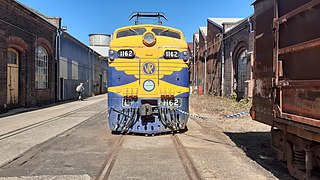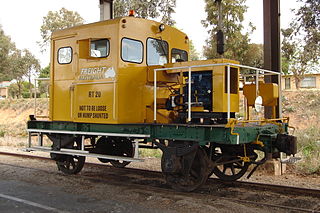
The F Class are a class of diesel locomotive shunters built by Dick Kerr Works for the Victorian Railways between 1951 and 1953. They are similar to the British Rail Class 11 and NS Class 600 shunting locomotives also built by English Electric during this period, but modified for use on the VR's 5 ft 3 in (1,600 mm) broad gauge.

The Victorian Railways X class was a mainline goods locomotive of the 2-8-2 'Mikado' type operated by the Victorian Railways (VR) between 1929 and 1960. They were the most powerful goods locomotive on the VR, aside from the single H class, H220, which was confined to the North East line, until the advent of diesel-electric traction, and operated over the key Bendigo, Wodonga, and Gippsland mainlines.

The C class was a mainline goods locomotive of the 2-8-0 'Consolidation' type that ran on the Victorian Railways between 1918 and 1962. Although its original design had some key shortcomings, a number of improvements were made over the class' long career on the VR, many of which were subsequently applied to other locomotive classes on the system.

The A2 class was an express passenger locomotive that ran on Victorian Railways from 1907 to 1963. A highly successful design entirely the work of Victorian Railways' own design office, its long service life was repeatedly extended as the Great Depression and later World War II delayed the introduction of more modern and powerful replacement locomotives.

The K class was a branch line steam locomotive that ran on Victorian Railways in Australia from 1922 to 1979. Although its design was entirely conventional and its specifications unremarkable, the K class was in practice a remarkably versatile and dependable locomotive. It went on to outlast every other class of steam locomotive in regular service on the VR, and no fewer than 21 examples of the 53 originally built have survived into preservation.

The N class was a branch line steam locomotive that ran on the Victorian Railways (VR) from 1925 to 1966. A development of the successful K class 2-8-0, it was the first VR locomotive class designed for possible conversion from 5 ft 3 in to 4 ft 8+1⁄2 instandard gauge.

The Victorian Railways J class was a branch line steam locomotive operated by the Victorian Railways (VR) between 1954 and 1972. A development of the successful Victorian Railways K class 2-8-0, it was the last new class of steam locomotive introduced on the VR. Introduced almost concurrently with the diesel-electric locomotives that ultimately superseded them, the locomotives were only in service for a relatively short time.
The DD class (later reclassified into D1, D2 and D3 subclasses) was a passenger and mixed traffic steam locomotive that ran on Victorian Railways from 1902 to 1974. Originally introduced on mainline express passenger services, they were quickly superseded by the much larger A2 class and were relegated to secondary and branch line passenger and goods service, where they gave excellent service for the next fifty years. The DD design was adapted into a 4-6-2T tank locomotive for suburban passenger use, the DDE (later D4) class. They were the most numerous locomotive class on the VR, with a total of 261 DD and 58 locomotives built.

The Victorian Railways L class was a class of electric locomotives built by English Electric and operated by the Victorian Railways and later V/Line from 1953 until 1987 primarily on the Gippsland line. They were the only class of main line electric locomotive operated in Victoria.

The B class are a class of diesel locomotives built by Clyde Engineering, Granville for the Victorian Railways in 1952–1953. Ordered and operated by the Victorian Railways, they initiated the dieselisation of the system and saw use on both passenger and freight services, with many remaining in service today, both in preserved and revenue service. Some were rebuilt as the V/Line A class, while others have been scrapped.

The C Class are a class of diesel locomotive built by Clyde Engineering, Rosewater for the Victorian Railways in 1977–1978.

The S class are a class of diesel locomotives built by Clyde Engineering, Granville for the Victorian Railways between 1957 and 1961.

The T class are a class of diesel locomotives built by Clyde Engineering, Granville for the Victorian Railways between 1955 and 1968.

The Victorian Railways rail tractors are a small shunting unit used by the Victorian Railways of Australia for moving railway wagons in at country stations and private sidings. Varying in power output and size, they are agricultural tractors on top of a four-wheeled steel rail wagon frame. RT1 was of a different design to the remainder of the class and is preserved at the Newport Railway Museum, Victoria.

The Victorian Railways B class was a class of 2-4-0 passenger locomotives operated by the Victorian Railways (VR) between 1862 and 1917, built by various builders. The B class locomotives are regarded as the first mainline VR motive power, and were highly successful in passenger operations.

The Williamstown Workshops was the first railway workshop operated by the Victorian Railways, located in the Melbourne inner western suburb of Williamstown.
The Victorian Railways No. 1 was the first government passenger steam locomotive on Victorian Railways. It was a 2-2-2 passenger locomotive operated by the Victorian Railways between 1858 and 1890 and again between 1893 and 1904, built by George England and Co., Newcastle upon Tyne, England.
The Victorian Railways J class of 1859 was a class of 2-2-2 main line passenger locomotives operated by the Victorian Railways between 1860 and 1912, built by Beyer, Peacock & Company, Manchester, England.
The Victorian Railways L class was a class of 2-4-0ST passenger locomotives operated by the Victorian Railways between 1861 and 1906, built by both George England and Co., Newcastle upon Tyne, England and Slaughter, Gruning & Co., Bristol, England.
The Geelong & Melbourne Railway Company operated a total of 1 locomotive that fell under the Whyte notation of 0-4-0T, with a Vertical boiler, between 1855 and 1860. Later it was operated by the Victorian Railways between 1860 and 1893. This was the second locomotive manufactured in Australia.















